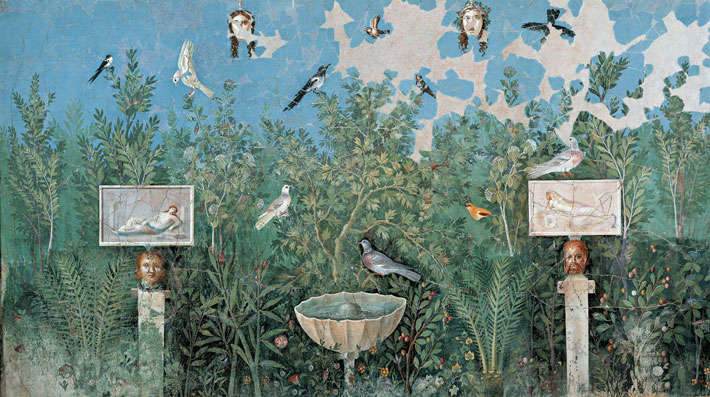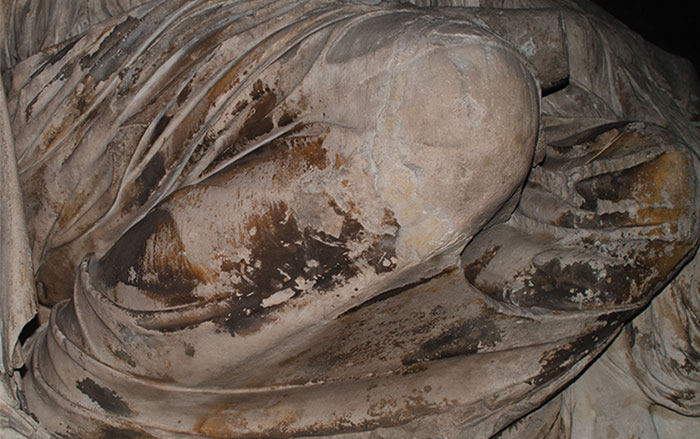
At some point, you inevitably want to repaint your dorm room, apartment, or house. You visit the hardware store, where you’re confronted with a dizzying array of colors with names like Tippy Toes and Lilting Laughter—these are real names from well-known paint companies—whose relation to actual hues is, like the meaning of the paintings in a famous Pompeian villa, a mystery. After carrying paint chips around for days and taping them on the wall, you finally pick a color. But then you have to decide whether to do the painting yourself, which will consume much more time than you have, and probably won’t end up looking great. A professional will likely do a better job in far less time, but it will cost you. All things considered, though, it’s probably best to pick the pro and draw up a contract, something archaeologist Hilary Becker of Binghamton University, who studies ancient pigments, is confident that Romans wanting to paint their houses did as well.
No contracts for Roman painting projects survive. But Romans certainly drew up contracts for mosaics and public works, examples of which are extant, and Becker’s work builds on prior scholarship to show that contracts were also struck for house painting. “A client would have chosen all the materials, how many layers of plaster to lay down, the colors, where the paint went on the wall, and the size of images,” Becker says. “Both the client and the painter would have wanted to protect themselves from anything that might cause a dispute. Law underlies so much of Roman life, and these guardrails helped avoid conflicts.” This was especially true when it came to painting because pigments could be extremely pricey and the choice of which to use could dramatically affect a job’s cost. “This all had to be worked out in advance,” Becker says. “The ancient sources tell us that if it was a really expensive pigment like cinnabar, which is mercury sulfide, or the blue copper carbonate mineral azurite, the client had to pay for it themselves.” Copious information about Roman pigments comes from the first-century A.D. naturalist Pliny the Elder, who wrote a great deal about their composition and disapproved of their extravagant use, which, says Becker, he considered evidence of Romans’ profligacy.

A cautionary house-painting tale is shared by the first-century B.C. author Vitruvius, who tells of the folly of Faberius, one of Julius Caesar’s scribes. Faberius had a taste for red and, to paint his colonnaded courtyard on Rome’s Aventine Hill, he went for the more expensive option—cinnabar—over cheaper red ocher. “Faberius would likely have been a freed slave, so this would have been a case of the sort of conspicuous consumption that Pliny the Elder would later deplore,” Becker says. Vitruvius warns that using cinnabar in open spaces where it will be exposed to sunlight or moonlight destroys the color—which is exactly what happened in Faberius’ courtyard. His prized peristyle turned black after just 30 days, “on which account he was obliged to agree with the contractors to lay on other colors,” writes Vitruvius.
While the ancient Romans were clearly devoted to painting their walls, less is known about the process that supplied the vivid colors painters used. In 1974, archaeologists working at the site of Sant’Omobono discovered the only surviving pigment shop from ancient Rome, which dates to the third to early fourth century A.D. While the site was excavated five decades ago, the initial findings are now being reexamined using the latest scientific technology.
Working with chemists including Ruth Beeston of Davidson College and Greg Smith from the Indianapolis Museum of Art at Newfields, Becker is currently analyzing pigments found in the shop to identify their composition. This might, in turn, help reveal where they came from. “There isn’t any evidence of manufacturing in the shop,” Becker says, “so I’m assuming the pigments were processed elsewhere.”
Thus far, Becker, Beeston, and Smith have identified many shades of red and yellow ocher, an iron-rich pigment called green earth, pink from the madder plant, a calcium carbonate white, and examples of the synthetic pigment known as Egyptian blue created by combining silica, lime, sodium carbonate, and copper. Becker says that their analysis of these pigments has the potential to provide surprising insights into the Roman economy. Being able to pinpoint what type of ocher was being sold, for example, would help establish how far pigments were transported, and studies of minerals sampled at mines might clarify the raw materials’ source. “When you think about color, it’s everywhere,” says Becker. “That’s what’s so exciting about this—it’s a lump of color, but it opens up a whole world.”











